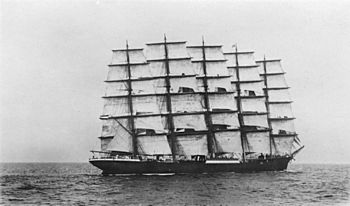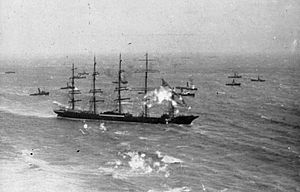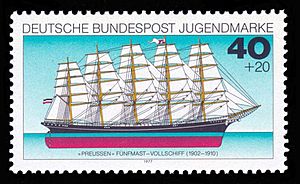Preussen (ship) facts for kids
|
Preussen under full sail
|
|
Quick facts for kids History |
|
|---|---|
| Name | Preußen |
| Namesake | State and Kingdom of Prussia (Preußen) |
| Owner | F. Laeisz Shipping Company |
| Route | Hamburg-Chile (12 journeys); 1 journey round the world in charter to Standard Oil Co. |
| Ordered | November, 1900 |
| Builder |
|
| Cost | M 1,200,000 (About US$300,000 then) |
| Yard number | 179 |
| Laid down | August 1901 |
| Launched | 7 May 1902 and christened the same day |
| Completed | 7 July 1902 |
| Commissioned | 10 July 1902 |
| Maiden voyage | 31 July 1902 to Iquique, Chile in 64 days |
| Homeport | Hamburg, Germany |
| Identification | |
| Fate | Wrecked near Dover on 6 November 1910, no loss of men |
| Badge | None; no figurehead, a volute instead |
| General characteristics | |
| Class and type |
|
| Tonnage | 5,081 GRT / 4,788 NRT |
| Displacement | 11,150 long tons (11,330 t) (at 8,000 long tons or 8,100 metric tons load) |
| Length |
|
| Beam | 53.8 ft (16.4 m) |
| Height | |
| Draft | 27.09 ft (8.26 m) |
| Depth | 33.59 ft (10.24 m) (depth molded) |
| Depth of hold | 32.48 ft (9.90 m) |
| Decks | 2 continuous steel, poop, forecastle, and midship island (bridge) decks |
| Deck clearance | 8 ft (2.4 m) |
| Installed power | no auxiliary propulsion; 2 donkey engines for sail winches, loading gear, pumps, generator |
| Propulsion | sail |
| Sail plan | |
| Speed | 20.5 knots (38.0 km/h) |
| Boats & landing craft carried |
4 lifeboats on the aft main deck |
| Capacity | 8,000 long tons or 8,100 metric tons load |
| Complement | 45, 49 max. |
| Crew | captain, 1st, 2nd, & 3rd mates, steward, cook, sailmaker, 38 to 42 able seamen and shipboys |
| Notes | small surgery, Jarvis patent brace winches for each mast |
Preussen (pronounced PROY-sin) was an amazing German sailing ship built in 1902. It was made of steel and had five masts, each carrying six square sails. This made it the only ship of its kind in the world!
The ship was named after Prussia, a German state and kingdom. For many years, Preussen was the only five-masted ship with full square sails ever built. It held this unique title until the Royal Clipper was launched in the year 2000.
Contents
History of the Preussen
Preussen was built at the Joh. C. Tecklenborg shipyard in Geestemünde, Germany. It was launched and named on May 7, 1902. The ship began its first journey on July 31, 1902, sailing to Iquique, Chile. Captain Boye Richard Petersen was in command. He even helped design the ship!
The idea for such a large ship came from Captain Robert Hilgendorf. He commanded another famous five-masted ship called Potosi. Legend says that German Emperor Wilhelm II asked Carl H. Laeisz, the ship owner, when a five-masted ship with full square sails would finally be built. This question inspired Laeisz to build Preussen.
Preussen's Amazing Journeys
Preussen was built very strongly. It could handle even very strong winds, like a force 9 gale. In such storms, eight people were needed to hold the large steering wheel!
The ship was mainly used to carry saltpeter (a type of salt) from Chile. It was incredibly fast and set many speed records. Sailors called her the "Queen of the Queens of the Seas" because of her looks and speed.
In 1903, Preussen made an amazing trip from Lizard Point to Iquique in just 57 days. This was a record that no other ship could match. She completed twelve "round trips" between Hamburg and Chile. She also made one trip around the world, sailing to New York and Yokohama, Japan. When she arrived in New York, almost everyone came out to see this unique tall ship.
Preussen had only two captains during its entire career: Captain Boye Richard Petersen and Captain Jochim Hans Hinrich Nissen. Both were skilled sailors who learned from Captain Robert Hilgendorf.
The Loss of the Preussen
On November 5, 1910, Preussen was on its 14th trip, carrying cargo to Chile. At 11:35 PM, a small British steamer named Brighton crashed into her. This happened about 8 miles (13 km) south of Newhaven. The Brighton tried to cross in front of Preussen, not realizing how fast the big ship was going (about 16 knots or 30 km/h).
Preussen was badly damaged. She lost her bowsprit (a large pole sticking out from the front) and part of her front mast. This made it impossible to steer the ship. The Brighton went back to Newhaven to get help. A tugboat called Alert was sent to assist Preussen.
A storm that November made it impossible to sail or tow Preussen to safety in Dover Harbour. The plan was to anchor her near Dover, but both of her anchor chains broke. Preussen was then pushed onto rocks at Crab Bay. She sank there because of the damage.
All the crew, cargo, and some equipment were saved from Preussen. However, her keel (the main support along the bottom of the ship) was broken, so she could not be saved. Today, she rests in about 6 meters (20 feet) of water. You can still see a few parts of Preussen at Crab Bay during low tides. The captain of the Brighton was found responsible for the accident and lost his license.
Technical Details of the Preussen
Preussen was built from steel. Its hull was 132 meters (433 feet) long. The ship was 16.4 meters (53.8 feet) wide. It could carry about 8,000 metric tons of cargo.
The five masts were fully rigged. This means they had many square sails, one above the other. In total, Preussen carried 47 sails! This included 30 square sails, 12 staysails (sails between the masts), four foresails (jibs), and a small spanker sail at the back. All these sails covered an area of about 6,806 square meters (73,260 sq ft).
Not just the hull, but also the masts and spars (the poles holding the sails) were made of steel. Most of the ropes were also steel cables. This made the ship very strong. Special winches helped sailors move the heavy yards (horizontal poles that hold the sails).
Ship Design and Speed
The five masts of Preussen had special names: fore, main, middle, mizzen, and jigger.
Preussen was designed as a "three-island ship." This meant it had three raised deck areas: the forecastle (front), the poop deck (back), and a middle deck called the "midship island." This middle deck was also known as a "Liverpool house." It provided dry and well-ventilated rooms for the crew, officers, and captain. The main steering wheel was on top of this middle deck, protected from large waves. There was also a second steering wheel for emergencies near the stern (back).
The ship had two small steam boilers. These powered four steam winches, a steam capstan (for lifting heavy things), the steering machine, and a generator for electricity. Four lifeboats were kept on a rack above the main deck.
Under good conditions, Preussen could reach speeds of 20 knots (37 km/h). Her best 24-hour journey was 392 nautical miles in 1908. Another time, she sailed 426 nautical miles in 24 hours in the South Pacific in 1904.
Preussen had a crew of 45 people. The steam engines helped them with tasks like pumping water, steering, and loading cargo. Many English sailors believed Preussen was the fastest sailing ship after the famous clipper ships. She was even faster than her sister ship, Potosí. Only a few clippers were faster, but they carried much less cargo.
Stamps
Preussen has been featured on postage stamps from several countries. These include the Falkland Islands, Germany, Grenada, Paraguay, and Sierra Leone.





